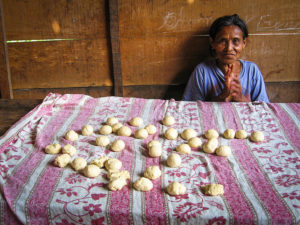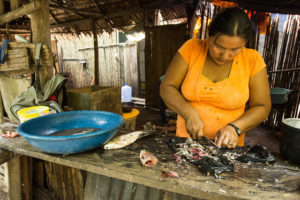
Firewood for fuel, fruits to feed their families, palm fiber for baskets, medicinal plants to heal their children — women in forest-dwelling communities in Latin America use a wide array of products from their farmland and forests in their daily tasks.
But when it comes to tenure rights to those forests or participation in decisions about their management, women are often left on the sidelines.
“Latin America’s land and forest tenure issues are marred with various social, legal and political complexities,” says social scientist Purabi Bose, former focal contact for the CGIAR Research Program on Forests, Trees and Agroforestry (FTA). “And women bear the brunt of it, directly and indirectly.”
Although some countries have policies to address those problems, there remain obstacles to implementing them, Bose says.
That leaves women — especially rural and indigenous women — particularly vulnerable, according to studies from Bolivia, Brazil, Colombia, Nicaragua and Mexico. Those studies are part of a Special Issue of the Women’s Studies International Forum, of which Bose was guest editor.
The topic is drawing increasing attention since UN Sustainable Development Goal No. 5 specifically calls for countries to develop policies to strengthen land rights and land ownership for women.
“That goal provides a rallying point to bring these issues more into public debate, not as something sidelined as a ‘gender issue’, but as part of a set of sustainable development goals that all of these countries have agreed on,” says Anne Larson, a principal scientist at the Center for International Forestry Research (CIFOR) and coauthor of a study on women and forest tenure in Nicaragua that is part of the Special Issue.
Negotiators at global climate summits are increasingly recognizing the need to involve women, especially indigenous women, in decisions about programs to reduce greenhouse gas emissions from deforestation and forest degradation (REDD+).
The importance of ensuring land and forest rights for indigenous people was also highlighted at the CIFOR-led Global Landscapes Forum in Bonn, Germany, in December.

CHALLENGES DIFFER FROM COUNTRY TO COUNTRY
In Latin America, the challenges take different forms in different countries, according to an overview paper by Bose, Larson and colleagues in the special issue.
In Colombia, where half of the 3 million people displaced during the country’s civil war are female, indigenous and Afro-Colombian women still suffer most from poverty and exclusion. Although women are beginning to receive land rights under recent legislation, true empowerment will require more support for women entrepreneurs in rural areas, researchers say.
Nicaragua has a larger percentage of women in congress than many other countries, but that empowerment has not trickled down to rural communities, where it is difficult for women to take leadership roles because of their household work load or because their husbands object, Larson says.
Survey respondents in Nicaragua agreed that women’s involvement in decisions about forest management was strongest within the household. They are also more likely to control the income from the forest products that they sell, such as fruits, herbs, honey or handicraft materials, than from timber, posts or firewood, which are mainly sold by men, her study found.
In Mexico, where nearly 86 percent of land titles were still held by men as of 2011, joint land titling remains a challenge, researchers found. Besides giving women land rights, joint titling would enable them to participate in community assemblies and hold elected positions in their communities.
Bolivia’s Gran Chaco region, in the country’s southeastern lowlands, is seeing changes in the land-tenure system as land and resources increasingly shift to production of cash crops and livestock.
That area is largely inhabited by Guaraní indigenous communities, and although communal property cannot be sold, there is an increasing possibility that land could become privatized in practice, if not legally, researchers say.
Because cash crops and cattle are generally controlled by men, that trend could leave women with the right to use land for subsistence agriculture, but no real control over land and resources.
“Gender inequality is worsened by women’s exclusion from access to the necessities of life,” Bose says.
“Household livelihoods remain suboptimal for women, while they continue to be excluded from making a full contribution to resource governance.”
International market demand that turned two Andean staples crops, quinoa and kañawa, into cash crops had a strong impact on Quechua women in the Bolivian highlands, the researchers found. As the crops became commodities, lack of land tenure rights excluded women from decisions about marketing those products.

Although women tried to form collectives to market value-added products, such as cakes and cookies, made from those crops, their lack land tenure made it difficult to establish formal enterprises.
When women do have access to land, the areas are often smaller than for men. That is the case in the Brazilian Amazon, where researchers found that women work areas averaging 25 hectares, compared to 60 hectares for men.
Deforestation and the expansion of industrial agriculture threaten those family farms, however, jeopardizing food security. In some areas, participation in collective microenterprises has empowered women, giving them greater technical skills for forest and crop management.
POLICIES MUST TARGET WOMEN
The studies reported in the Special Issue point to a need for policies that actually make a difference for women, Bose says.
“Policymakers never discuss the criteria for successful policies,” she says. “These studies identify loopholes in policies and, by doing so, identify ways of overcoming them.”
One common thread throughout the studies is the need for effective implementation of policies, Bose says.
“Providing a legal framework and creating new policies that recognize women’s rights to land is important, but not an end in itself,” she says. “Ensuring the implementation of these rules and policies is what is really critical for maximum impact.”
Because women’s access to land tenure can vary not just between countries but also within them, the studies reveal a need for more comparative analysis, Bose says.
Comparing women’s tenure rights in the Colombian Amazon to those of coffee farmers or Afro-Colombian women “would make it possible to identify whether and how one national policy influences the diversity of women’s roles and responsibilities in different landscapes,” Bose says.
Those factors could then be compared across countries to analyze regional trends.
That points to a need for researchers from different disciplines to be involved in studies in the field, Bose says.
“We need to listen more to the voices of rural and indigenous women,” she says. “I think it is the responsibility of researchers to tell these women’s story to the world.”
By Barbara Fraser, originally published by CIFOR’s Forests News.
For more information on this topic, please contact Purabi Bose at purabibose@gmail.com or Anne M. Larson at a.larson@cgiar.org.
The Special Issue of the Women’s Studies International Forum grew out of the CGIAR Research Program on Forests, Trees and Agroforestry. This Forests News article was supported by funding from the CGIAR Research Program on Policies, Institutions and Markets.
This research forms part of the CGIAR Research Program on Forests, Trees and Agroforestry, and was supported by the CGIAR Research Program on Policies, Institutions and Markets, which are supported by CGIAR Fund Donors.











